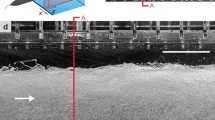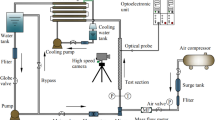Abstract
In commercial nuclear reactors, heat exchangers, and bubble column reactors, two-phase flows are present. When predicting the safety and process efficiency of these systems, it is necessary to model the behavior found in them. The most common model used in two-phase flows is the two-fluid model due to its practicality. In the two-fluid model, two key parameters are the void fraction (VF, also known as the gas fraction or gas holdup) and interfacial area concentration (IAC, also known as interfacial area density). In order to produce accurate results, the bubbles are separated into groups based on the transport properties. When benchmarking models, experimental data are required. In many cases the experimental data are produced with the use of intrusive conductivity or optical probes. Recently a new data processing algorithm was developed to improve bubble interface identification and implement a method to group bubbles based on diameter rather than chord length. In this paper, the new data processing algorithm is evaluated by comparing the results when using both conductivity and optical probes. At a data acquisition frequency of 22 kHz, the optical probe collected more bubbles than the conductivity probe using the old algorithm. The new algorithm results in similar bubble counts for both instruments. There is a shift in bubbles from Group 1 to Group 2 in both the optical and conductivity probes. The new bubble size calculation means that several bubbles, which were previously classified as “spherical/distorted”, are now classified as “cap/slug/churn” bubbles for both the optical and conductivity probes. However due to low sample rates used in this research, the IAC is larger for the conductivity probe when compared to the optical probe by 10% to 60%. While some of these changes were expected, the increase in the IAC was larger than the reported uncertainty of the instruments.
Similar content being viewed by others
Change history
05 February 2022
A Correction to this paper has been published: https://doi.org/10.1007/s42757-022-0132-z
References
Abuaf, N., Jones, O. C. Jr., Zimmer, G. A. 1978. Optical probe for local void fraction and interface velocity measurements. Office of Scientific and Technical Information.
Danel, F., Delhaye, J. M. 1971. Sonde optique pour mesure du taux de présence local en écoulement diphasique. Mesure-Regulation-Automatisme, 36: 99–101.
Farag, H. I., Mejdell, T., Hjarbo, K., Ege, P., Lysberg, M., Grislingas, A., de Lasa, H. 1997. Fibre optic and capacitance probes in turbulent fluidized beds. Chem Eng Commun, 157: 73–107.
Frijlink, J. J. 1987. Physical aspects of gassed suspension reactors. Ph.D. Thesis. Delft University of Technology, Netherlands.
Galaup, J. P., Delhaye, J. M. 1976. Utilization of the miniaturized optical probes for void fraction and gas velocity measurements in two-phase flow. La Houille Blanche, 1: 17–30.
Ishii, M. 1975. Thermo-Fluid Dynamic Theory of Two-Phase Flow. Paris: Eyrolles.
Ishii, M., Kim, S. 2001. Micro four-sensor probe measurement of interfacial area transport for bubbly flow in round pipes. Nucl Eng Des, 205: 123–131.
Ishii, M., Kim, S., Uhle, J. 2002. Interfacial area transport equation: model development and benchmark experiments. Int J Heat Mass Transfer, 45: 3111–3123.
Ishii, M., Revankar, S. T. 1991. Measurement of interfacial area using four sensor probe in two phase flow. NASA STI/Recon Technical Report N, 91.
Kataoka, I., Ishii, M., Serizawa, A. 1994. Sensitivity analysis of bubble size and probe geometry on the measurements of interfacial area concentration in gas-liquid two-phase flow. Nucl Eng Des, 146: 53–70.
Kim, S. 1999. Interfacial area transport equation and measurement of local interfacial characteristics. Ph.D. Thesis. Purdue University.
Kim, S., Fu, X. Y., Wang, X., Ishii, M. 2001. Study on interfacial structures in slug flows using a miniaturized four-sensor conductivity probe. Nucl Eng Des, 204: 45–55.
Miller, N., Mitchie, R. E. 1969. The development of a universal probe for measurement of local voidage in liquid-gas two-phase flow systems. Two-Phase Flow Instrumentation, 82–88.
Miller, N., Mitchie, R. E. 1970. Measurement of local voidage in liquid/gas two phase flow systems using a universal probe. J Brit Nucl Energy Soc, 9: 94–100.
Mills, C. S. L., Schlegel, J. P. 2019. Interfacial area measurement with new algorithm for grouping bubbles by diameter. Exp Comput Multiph Flow, 1: 61–72.
Neal, L. G., Bankoff, S. G. 1963. A high resolution resistivity probe for determination of local void properties in gas-liquid flow. AIChE J, 9: 490–494.
Talley, J. D., Worosz, T., Kim, S. 2015. Characterization of horizontal air-water two-phase flow in a round pipe part II: Measurement of local two-phase parameters in bubbly flow. Int J Multiphase Flow, 76: 223–236.
Tian, D. G., Yan, C. Q., Sun, L. C. 2015. Model of bubble velocity vector measurement in upward and downward bubbly two-phase flows using a four-sensor optical probe. Prog Nucl Energ, 78: 110–120.
Xue, J. L., Al-Dahhan, M., Dudukovic, M. P., Mudde, R. F. 2008. Bubble dynamics measurements using four-point optical probe. Can J Chem Eng, 81: 375–381.
Author information
Authors and Affiliations
Corresponding author
Rights and permissions
About this article
Cite this article
Mills, C., Schlegel, J.P. Comparison of data processing algorithm performance for optical and conductivity void probes. Exp. Comput. Multiph. Flow 2, 174–185 (2020). https://doi.org/10.1007/s42757-019-0017-y
Received:
Revised:
Accepted:
Published:
Issue Date:
DOI: https://doi.org/10.1007/s42757-019-0017-y




